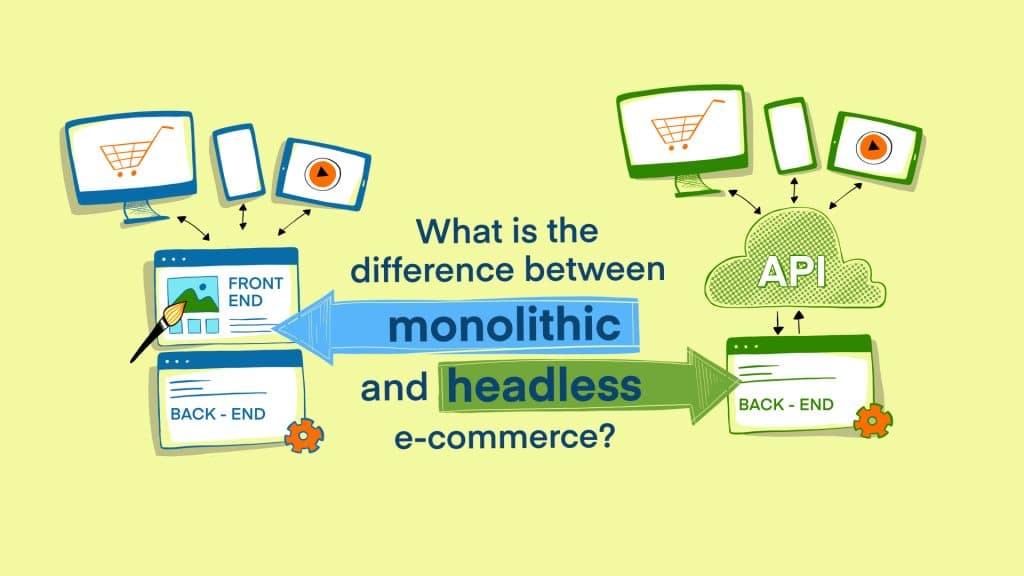
The problem with technology-driven industries like ecommerce is that new buzzwords spring up constantly. It can be hard to know if the latest jargon is the next big thing or just a rebranding of an existing best practice. The term headless ecommerce has continued to gain traction, and online sellers are wondering if they need to adopt it or stay the course with their current ecommerce models and operational workflows.
The vagaries surrounding what is being branded as headless ecommerce don’t help. To best understand this trend, we must start by simply defining it.
What is Headless Ecommerce?
Headless ecommerce is the separation of the front-end, customer-facing elements of online sales from the back-end order processing, supply chain, and fulfillment components. Both sides can communicate through API calls, which keep everything in sync across multiple channels, modules, and integrations. If implemented well, this front-end and back-end independence spreads the IT and content burdens and is touted as an efficient way to promote innovation and flexibility when scaling an ecommerce brand.
This headless style of ecommerce contrasts with more monolithic and traditional approaches, where everything on both the customer and technical sides is tied together—unable to be managed or changed independently from each other. What makes this particularly problematic—particularly for modern omnichannel retailers—is that issues or downtime on either the front or back end almost always lead to issues on the other.
The end result is a slower pathway to growth and increased potential for technical challenges. In between the headless and traditional/monolithic online sales models lies decoupled ecommerce. This headless hybrid keeps the front end and back end separate, but there is still a connecting thread: Unlike truly headless options, decoupled ecommerce content management is carried out on the back end and pushed out to the various front ends.
This allows omnichannel sellers to retain some of the control afforded by traditional ecommerce models while also gaining some of the most valuable flexibility of headless ecommerce. Descartes Sellercloud’s omnichannel catalog management features exemplify this decoupled ecommerce approach.

What are the Benefits of Headless Ecommerce?
While there are many flavors of headless ecommerce being marketed these days, there are common benefits that most share:
Compartmentalized Development
The differences between successful front-end and back-end design can be stark. Each requires unique skills and attention to distinct details. Headless ecommerce models allow your brand to focus on technical talent where they can have the greatest impact. UX, UI, and marketing specialists can be left to manage front-end content while your technical IT specialists can keep the back-end running smoothly.
Simplified Upgrades and Enhancements
By separating front- and back-end development, you can upgrade or modify one without disrupting the other. This is perhaps the most marketable component of headless ecommerce. You can be sure your interfaces, APIs, and software systems remain current and secure while minimizing cross-departmental coordination.
Speed
Implemented correctly, headless ecommerce gives your brand agility and flexibility that is impossible when your front-end and back-end are linked. This division means you can offer promotions, create new product listings, and generate timely content without disrupting the underlying back-end operations.
Similarly, your back-end platforms can roll out updates, add new APIs, and integrate new modular partners without upsetting the forward-facing customer experience. This is where things get interesting. In reality, most omnichannel sellers—Descartes Sellercloud users included—already reap many of the benefits of headless ecommerce in their current setups, even if they have never used the term.
For instance, Descartes Sellercloud’s omnichannel growth platform allows users to manage every aspect of their inventory, catalog, and third-party modular integrations across every channel they sell from a single interface. When omnichannel orders come in, they can be processed according to customizable rules based on variables like channel, order, destination, product, customer, and more.
These rules and workflows are handled independently of the customer-facing listings and content on the channel front-ends where you sell. If you are looking to break out of the traditional, monolithic ecommerce sales model, Descartes Sellercloud’s API and EDI integrations with over 350 top-rated ecommerce partners allow you to use a decoupled, modular-style approach to create the ideal online retail setup for your brand.
Contact us directly for a free demo and consultation and see how our approach to omnichannel growth is no fad.




